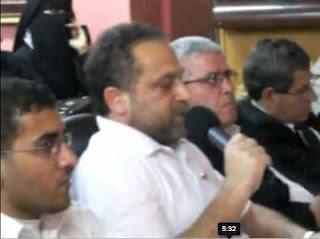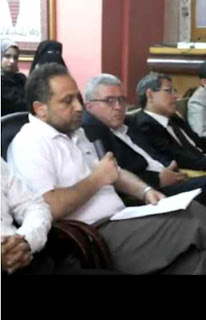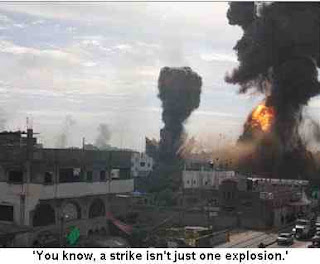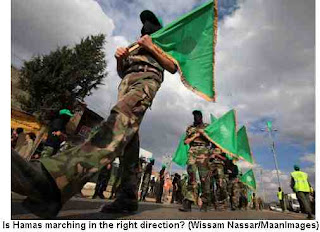Publically it won’t recognise Israel but Diplomatically it accepts 2 States
An important interesting article by veteran Palestinian activist and academic, Haidar Eid. Whereas in the West there is a pretence to maintain, that Hamas wishes to wipe out all Jews, refuses to accept Israel etc., the reality is that Hamas would indeed accept a 2 states solution, but wouldn’t abase itself in the way Fateh/PLO and the Palestinian Authority/Abbas has by accepting a mini-version of an Indian Reservation.
It is unfortunate that being an Islamic party, it looks backwards and has no coherent policy that it can lay out both before imperialism and its own supporters. Hence it says one thing to one person and another to someone else, a tactic that the Zionists are more than happy to pick up on.
Tony Greenstein
Hamas’s victory in the 2006 Palestinian Legislative Council elections surprised everyone, including its own members and leaders. Many local and international activists were also relieved, as the victory was a blow to the Bush doctrine in the Middle East. It was also a test of the credibility of the liberal democratic approach and its applications in the region.
This article is not concerned with domestic or foreign reactions and attempts to topple the sole democratic experience in the Arab world. Rather, it tackles Hamas’s failure to live up to its own commitments to its constituencies, many of whom were not necessarily supporters of the movement. It also examines the extent of Hamas’s credibility in committing to the social contract that major democracies abide by in terms of respecting individual citizens and safeguarding their dignity. This contract applies not only to male but also to female citizens.
First, one ought to reiterate the fact that Hamas is part of the resistance camp. In addition to the enormous sacrifices that many of its leaders and cadres have made, if creatively invested, Hamas’s actions ultimately support the interests of the Palestinian cause. This implies the following question: has Hamas been able to actually build on this high level of commitment and sacrifice, not only on the part of the movement but of Palestinians in general?
Despite its somewhat fiery statements, Hamas’s impulse and willingness to deal with American propositions are indeed astonishing. Two letters were sent, as far as I know, to the new Obama administration after the term of former US President George W. Bush ended. The Americans emphasized that they declined to accept the first letter. However, it is the content of the letters and how they reflect the aspirations of Palestinians — both in all of historic Palestine as well as in the Diaspora — that is significant.
The content of these letters along with statements made by senior Hamas leaders indicate to the US Hamas’s acceptance of and commitment to the two-state solution; i.e. the creation of an independent Palestinian state on the territories occupied by Israel in 1967. Yet many Hamas leaders simultaneously accentuate their refusal to recognize the State of Israel and accept the two-state solution! Simply put, the Palestinian leadership elected by the majority of one-third of the Palestinian people, i.e. the population in the West Bank and Gaza Strip, is announcing its commitment to a racist solution that disregards the rights of 6-7 million Palestinian refugees, and the national and cultural rights of 1.4 million Palestinians in Israel.
The grave danger underlying this position lies in the fact that it follows the downward trajectory of the right-wing secular dominion over Palestinian leadership since the 1960s. It also follows the downfall of the Stalinist Palestinian left, whose leadership was co-opted by the nongovernmental organization sector and the Palestinian Authority, and commandeered the internal decision-making of the respective Palestinian organizations. This led to the adoption of positions that were radically different from those they had historically advocated. Indeed, those positions were forsaken with pragmatic justifications that are antithetical to the questions the left should be able to answer creatively, such as the two-state solution and membership in the hijacked and discredited Oslo-era Palestine Liberation Organization.
Therefore, many international supporters and Palestinian activists opposing the Oslo accords, or the second Nakba as the late Edward Said referred to them, have had exaggerated “hope.” Hamas’s success in the 2006 elections was due mainly to the fact that the Palestinian national movement failed to accomplish its declared goals, abandoned the “interim program” and accepted an exceptionally racist solution that denies internationally legitimated historical rights. However, Hamas’s acceptance of the two-state solution, or a Palestinian state within the 1967 borders as it is often called, is not at odds politically with either the left or right wing of the national movement.
But what does this state look like? And does Hamas have an alternative to the two-state, or two-prison, solution which has become impossible to achieve?
The experience of Hamas rule in the Gaza Strip offers a miniature model of an Islamic state, whereas the West Bank stands as the Bantustan state to be declared in November 2011. It is common knowledge that Gaza has recently undergone ideological social transformations through laws that are enforced without being enacted. Such laws target individual freedoms, particularly those of women, who are no longer allowed to smoke water pipe in public or ride behind their spouses on motorcycles. Likewise, female students are now forced to wear the jilbab and the hijab, while female lawyers must wear the hijab. Of course, these practices claim to “protect our customs and traditions,” but is there a traditional text that bars women from smoking, for instance? The democracy that provided the foundation for the 2006 elections is based on guaranteeing individual freedoms. Many statements made by Hamas leaders inside and outside of Gaza before the elections emphasized that those leaders would respect such freedoms if elected.
The transformation of many members of the resistance, who are willing to sacrifice their lives for their homeland and who exerted impressive efforts to defend Gaza in 2009, into religious police like those in Saudi Arabia requires a serious and critical revision by Hamas.
Therefore, it is obvious that Hamas is unable to realize that the war on Gaza in 2009 has created a new political reality whereby Israel pulled the trigger on the racist two-state/two-prison solution. Hamas insists on adopting this approach and claims it is a temporary tactic until the balance of power shifts, as the movement assumes it will within the truce period of ten or twenty years. During this time, it plans to build a state after its model in Gaza. This only indicates the lack of a clear strategic vision to end the conflict, a vision that draws on past global struggles against colonialism, particularly against the abhorrent South African apartheid regime, which collapsed resoundingly in 1994.
Unfortunately, there has been no indication, based on my reading of many statements made by Hamas leaders, of a clear understanding within the movement either of the apartheid nature of the State of Israel or of the tools used by the South African anti-apartheid movement. One such tool is the international boycott campaign, without which the apartheid regime would not have ended. This demonstrates Hamas’s failure to understand the role of the boycott, divestment and sanctions movement (BDS). As a recent report by the Israel-based Reut Institute indicates, even the Israelis themselves are concerned about the momentum the BDS movement is gaining. There is no statement whatsoever, either in public speeches of Hamas officials or in its literature, which indicates an understanding of these efforts which, as Reut claimed, served to “delegitimize Israel” and “pose a threat to its very existence.”
In a fashion similar to the boycott movement against the South African apartheid regime, the BDS movement is guided by a national boycott committee, the BDS National Committee (BNC), particularly the Palestinian Campaign for the Academic and Cultural Boycott of Israel (PACBI). The difference between the two experiences is that in South Africa, the United Democratic Front (UDF) — a broad coalition of civil society groups struggling against apartheid within South Africa — founded its movement on linking grassroots popular resistance with international solidarity. This was particularly true of the boycott campaign. The failure of both the nationalist and Islamist wings of the Palestinian leadership to study, build upon and link this experience with the history of Palestinian resistance must also be rectified immediately.
However, it is evident that the development of an alternative leadership cannot wait. As a benchmark in the history of the Palestinian struggle, the formation of the BNC along with its main objectives have reconnected the various segments of the Palestinian people to stand in the face of occupation, colonization and institutionalized racist discrimination against Palestinian citizens of Israel, and to call for the return of refugees. These indivisible demands distinguish the new alternative Palestinian strategy. Yet the question remains: is Gaza willing to constructively interact with such a positive development in the Palestinian struggle with openness to the other national players and without a narrow factional vision?
Haidar Eid is Associate Professor of Postcolonial and Postmodern Literature at Gaza’s al-Aqsa University and a policy advisor with Al-Shabaka, the Palestinian Policy Network. This article was originally published in Arabic by Ma’an News Service.



